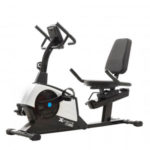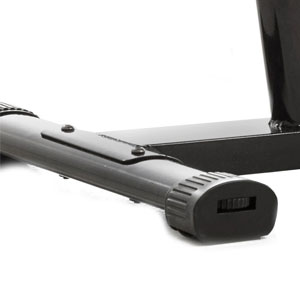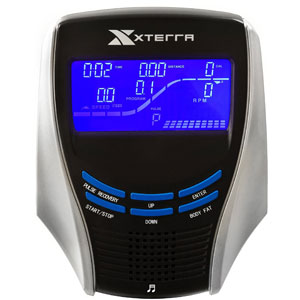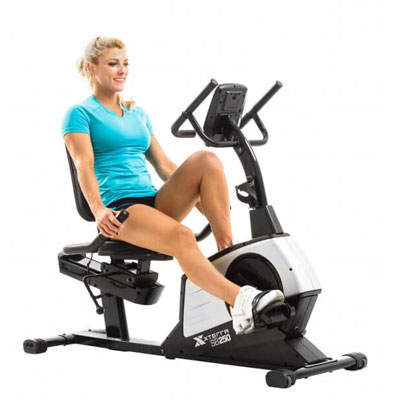| Unit | Size | Supported weight | Flywheel weight | Resistance | Workout programs |
|---|---|---|---|---|---|
XTERRA SB250 Check Discounted Price | L:60.3" W:24.4" H:42.2" | 300 lbs | 13.5 lbs | Eddy current, 24 levels | 12 preset, 5 HRC, 4 custom, Recovery, BMI, |
The XTERRA SB250 recumbent bike shares many similarities with the SB150 model that we’ve already covered here. However, it offers a superior weight capacity, has a slightly heavier internal flywheel, and a few extra features. It’s a mid-range exercise bike made for home use but does have an automatic resistance system.
Key Features and Specifications
- Assembled dimensions: 60.3L x 24.4W x 42.2H inches (153L x 62W x 107H cm)
- Assembled weight: 87.5 lbs (40 kg)
- Flywheel weight: 13.5 lbs (6 kg)
- Supported weight: 300 lbs (136 kg)
- Drive: Belt
- Resistance: Motorized magnetic, 24 levels
- Console programs: 12 preset, 5 heart rate, 1 body fat, 1 recovery, 4 custom programs
- Extras: Sound system, bottle holder
- Warranty: Frame 5 years / Parts 1 year / Labor 1 year
Frame construction
The XTERRA Fitness SB250 exercise bike features a 2-piece frame, but unlike the Gold’s Gym 400R for example, the seat has its own rail adjustment system rather than the knob adjustment system on the lower bar of the frame. The main frame of the bike is made of durable steel tubing, coated with a corrosion-resistant frame. The color of the paint finish is black, this being the only color available for this trainer (at least for now). Of course, the bike’s construction also integrates several ABS parts. The most notable are the covers of the flywheel and the covers of the seat base bar.
example, the seat has its own rail adjustment system rather than the knob adjustment system on the lower bar of the frame. The main frame of the bike is made of durable steel tubing, coated with a corrosion-resistant frame. The color of the paint finish is black, this being the only color available for this trainer (at least for now). Of course, the bike’s construction also integrates several ABS parts. The most notable are the covers of the flywheel and the covers of the seat base bar.
The XTERRA SB250 isn’t an extremely large fitness machine but does take approx. 60″L x 24″W (153 x 62 cm) of floor space. Plus, it is recommended to leave at least two feet of clearance on each side of the bike, and at least one foot of clearance at the front and rear for ease of access.
The fully assembled bike is fairly heavy compared to other models. It weighs approx. 87.5 lbs (40 kg), which is more than twice the weight of the average road bike. All this weight plays an important role in the bike’s overall stability. Also, the bike’s rear base features two adjustable stabilizers which allow you to perfectly level it on any type of floor.
Despite its weight, this recumbent exercise bike is fairly easy to move, once it is completely assembled. Its front base integrates two small wheels that facilitate its relocation. So, by lifting it by the seat or by the rear base, you won’t be handling more than 30% of its total weight when relocating it.
One last aspect to mention here regards the bike’s step-through frame design. Not all recumbent bikes have this construction, so this can be a plus especially for users with certain disabilities.
Seat and handlebars
The XTERRA SB250 features a seat designed for comfort. Both the seat pad and the backrest pad have a 2″ (5 cm) thick layer of foam padding and durable, double-stitched vinyl covers. The seat pad is approx. 14″ (35.5 cm) wide, offering plenty of contact surface while the backrest has a sturdy metallic backbone and provides excellent lumbar support.
a 2″ (5 cm) thick layer of foam padding and durable, double-stitched vinyl covers. The seat pad is approx. 14″ (35.5 cm) wide, offering plenty of contact surface while the backrest has a sturdy metallic backbone and provides excellent lumbar support.
The bike’s seat is adjustable. It is attached to a rail system featuring a level adjustment mechanism. This being said, you can move the seat closer or farther from the pedals while being seated, by simply pulling the lever on the right side, under the seat.
The adjustment rail offers several inches of travel for the seat. Differently put, the bike can accommodate users between 5’0″ and 6’5″ (153 – 196 cm) allowing a complete leg extension. It is also durable enough to support users up to 300 lbs (136 kg), quite a bit more than the SB150 model which only has a weight capacity of 265 lbs (120 kg).
The XTERRA SB250 is equipped with two sets of handlebars; one attaches to the seat assembly, the other one to the front mast. The seat handlebars have a different design than the ones on the SB150. Their front grips are curved up offering a better positioning for the hands. They don’t adjust independently from the seat. They also integrate pulse sensors.
The front handlebars have a multi-grip design. They are directly attached to the front mast so they’re also non-adjustable. However, the front mast of the bike is slightly curved towards the user to eliminate an awkward position if holding on to the front handlebars while pedaling. Both sets of handlebars feature a layer of foam material to provide a better grip and optimal comfort.
Resistance and drive
The XTERRA Fitness SB250 exercise bike is equipped with an automatic magnetic resistance system. This means the bike requires an external power source. An adapter with cable is included with it; the connector for it is above the front base of the unit. It also means that the bike can adjust the resistance automatically and it has preset workout programs.
means the bike requires an external power source. An adapter with cable is included with it; the connector for it is above the front base of the unit. It also means that the bike can adjust the resistance automatically and it has preset workout programs.
The bike’s resistance system consists of two main elements. One is a small servo motor, the other is a magnetic brake. When you adjust the resistance from the console (or when the console adjusts the resistance automatically), the motor moves the magnets closer or farther from the flywheel, increasing or decreasing the pedaling difficulty.
The bike makes available 24 levels of resistance, while most bikes with a manual resistance system only offer 8 tension levels. Needless to say, this considerably improves the micro-adjustment possibilities. The first resistance levels deliver a light pedaling difficulty for a light impact workout. Conversely, the top resistance settings deliver considerably more resistance, simulating a fairly steep climb.
The bike is equipped with a 13.5 lbs (6 kg) flywheel. This element has a balanced design in order to provide a smooth pedaling motion. It is also bi-directional, allowing you to pedal in reverse. However, coasting on the bike is not possible as it is the case for most road bikes; the flywheel does not spin if the pedals are stationary.
The crankset integrates a 7-inch (17.7 cm) disc, and two solid steel arms. The pedals are made of heavy-duty nylon material with a metallic axis. They are also weighted in order to always turn face-up if you remove your feet from them. Plus, they’re equipped with adjustable straps for extra foot stability.
One last aspect to mention here regards the internal drivetrain. Like most other exercise bikes with a magnetic resistance system, the SB250 features a belt drive system. This offers a few advantages over a chain drive. For example, the belt does not require lubrication. It also generates less vibration than a chain promoting a smoother and quieter pedaling motion.
Console
This XTERRA exercise bike is equipped with a mid-range console. It features a 5.5″ LCD display with LED backlight and large digits for superior readability. The display tracks all the important workout metrics, including time, distance, speed, RPM, calories, and pulse. All these values are shown on the display simultaneously so you don’t have to use a scan function to rotate them.
backlight and large digits for superior readability. The display tracks all the important workout metrics, including time, distance, speed, RPM, calories, and pulse. All these values are shown on the display simultaneously so you don’t have to use a scan function to rotate them.
The speed and distance values are set by default to imperial units (mph and miles) but there is the possibility to change them to metric units (km/h and kilometers). Also, the unit is not telemetric. This means it can only track your pulse if you hold on to the sensors integrated into the seat handgrips. It cannot communicate with POLAR or any other wireless HR chest strap transmitters.
The bike does not have a Bluetooth function or online connectivity, but does have 24 built-in programs to keep you motivated. The first program (P1) is the Manual Mode. This gives you the possibility to manually adjust the resistance as you like during pedaling. The P2 – P13 programs are preset; to give you an idea with regards to their setup, here’s their name list: Steps, Hill, Rolling, Valley, Fat Burn, Ramp, Mountain, Intervals, Random, Plateau, Fartlek, and Precipice. If one of the preset programs is selected, the bike will auto-adjust the pedal resistance.
Next, the P14-P17 are user setting programs. For each one of them, you can create your own custom program profiles and save them to re-use every time you want. The P18-P22 are Heart Rate programs. The first four have preset HR targets for 55%, 65%, 75%, and 85% HRC, while the 22nd program gives you the possibility to select the desired custom HRC. During each one of the HR programs, the bike will auto-adjust the resistance depending on your current pulse rate, increasing difficulty if your BPM drops, or reducing difficulty if your pulse is too high.
The 23rd program is the Body Fat program. This requires your data input (weight, height, gender, and age) for a thorough calculation of your body fat percentage. It also makes available 6 workout modes depending on your body fat level.
Finally, a 24th program is the Recovery Program. Just as the Body Fat program, the Recovery function has its own quick-access key on the console. This program tracks the amount of time your heart takes to return to normal after your workout. Based on the result, it will give you a fitness rating between F1 (excellent) and F6 (poor).
One last notable console feature is the integrated sound system which is compatible with most smartphones and MP3 players. Thus, you can connect your phone to the console (via AUX cable which is included) in order to listen to your music through the integrated speakers.
Assembly and Maintenance
The bike’s drive and resistance elements are already assembled, connected to the front frame piece, and covered by the ABS side panels. Therefore, in terms of assembly, you only need to connect the two main frame parts together, add the two base bars, the seat, the seat pads, the front mast, the handlebars, the console, and the pedals. This may take more than an hour, but it’s definitely not a complicated task. Plus, the manual provides very clear assembly instructions and illustrations, and a basic toolkit is also included.
Maintenance pretty much requires keeping the bike clean and checking its joints periodically. The internal parts do not require lubrication or any maintenance whatsoever.
The Pros
- Sturdy frame – can support users up to 300 lbs;
- Adjustable stabilizers on the rear base;
- Step-through design;
- Foam-padded seat and backrest;
- Adjustable seat;
- Pulse sensors integrated into the seat handlebars;
- Silent automatic magnetic resistance system with 24 tension levels;
- Weighted pedals with adjustable straps;
- 5.5″ LCD display console with LED backlight;
- 12 preset programs available;
- 5 HRC programs;
- 4 custom programs;
- Body Fat program;

- Recovery Test function;
- Sound system included;
- Bottle holder included;
- Little maintenance required;
- Easy to assemble;
- Excellent warranty.
The Cons
- No online connectivity;
- No tablet holder.
Summary
The XTERRA Fitness SB250 is a mid-range recumbent bike designed for home use. It features an eddy current resistance system with 24 levels of difficulty, superior micro-adjustability and ergonomics, and a console with 24 workout programs. It also has a pretty sturdy frame construction with a weight capacity of 300 lbs. It’s an excellent exercise bike for light to medium-intensity cardio workouts, recovery training, interval training, muscle toning, and weight loss. In all, it offers a pretty decent value for the price.


Does this bike require a standard 110 electric connect
Yes, it does and comes with an adapter.